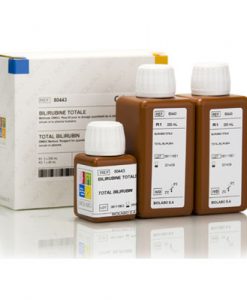Cromatest Total Protein Biochemistry Reagent
৳ 940৳ 1,200 (-22%)
In stock
Cromatest Total Protein Biochemistry Reagent
Packaging Size: 1x100 ml
Origin: Spain
Brand : Cromatest / Linear
Packaging Type: Bottle
Test/Pack: 100 Test
Method: colorimetric method
Cromatest Total Protein Biochemistry Reagent
PRINCIPLE
In the biuret reaction, a chelate is formed between the Cu2+ ion and the peptide bonds of the proteins in alkaline solutions to form a violet colored complex whose absorbance is measured photometrically. The intensity of the color produced is proportional to the concentration of protein in the sample.1-2
REFERENCE VALUES3
Serum, plasma
| Adults | 6.6-8.7 g/dL (66-87 g/L) |
| Prematures | 3.6-6.0 g/dL (36-60 g/L) |
| Newborns | 5.3-8.9 g/dL (53-89 g/L) |
| Pregnancy | Concentration lowers from 69 to 61 g/L |
Total serum protein is lower by 4 to 8 g/L with the subject supine than with the subject ambulatory.
Plasma
Plasma protein is 2 to 4 g/L higher due to the presence of fibrinogen in the sample.
It is recommended that each laboratory establishes its own reference range.
Best Quality Diagnostic Products Buy from Medistore

REAGENT COMPOSITION:
R1: Biuret reagent. Cupric sulfate 6 mmol/L, sodium-potassium- tartrate 21 mmol/L, potassium iodide 6 mmol/L, sodium hydroxide 0.75 mol/L. C R:3
CAL : Protein standard. Bovine serum albumin 7 g/dL (70 g/L). Secondary standard traceable to SRM 927
STORAGE AND STABILITY:
Store at 2-8ºC.
The Reagent and Standard are stable until the expiry date stated on the label.
REAGENT PREPARATION
The reagents are ready-to-use.
SAMPLES
Serum, EDTA or heparinized plasma, and exudates.
Total protein is stable in serum and plasma for 1 week at room temperature, for at least 1 month refrigerated at 2-8ºC, and for up to 2 months at –20ºC.
Buy Hematology Analyzer Reagent at best price from Medistore
QUALITY CONTROL
The use of a standard to calculate results allows to obtain an accuracy independent of the system or instrument used.
To ensure adequate quality control (QC), each run should include a set of controls (normal and abnormal) with assayed values handled as unknowns.
CLINICAL SIGNIFICANCE
The serum content of the soluble proteins, those circulating in extracellular and intracellular fluids, has been used as a marker to aid in clinical diagnosis. The main diagnostic tests are those measuring serum total protein and serum albumin.
Collectively, serum total protein including albumin is mainly involved in the maintenance of normal water distribution between tissues and the blood and responsible for maintaining the oncotic pressure of plasma and is used to transport many substances including macromolecules.
Hyperproteinemia o hyperalbuminemia, usually occurs during multiple myeloma caused by high levels of the monoclonal immunoglobulins, dehydration, excessive water loss, as in severe vomiting, diarrhea, Addison’s disease or diabetic acidosis. The hemoconcentration, decrease in the volume of plasma water, is reflected as a relative hyperproteinemia since concentration of all the individual plasma proteins are increased to the same degree.
Hypoproteinemia o hypoalbuminemia usually occurs in edema, malnutrition, nephrotic syndrome, malabsorption and severe liver cirrhosis. Since albumin is present in such high concentration low levels of this protein alone may also cause hypoproteinemia
ANALYTICAL PERFORMANCE
- Linearity: Up to 12 g/dL
- Precision
| mg/dL | Within-runl | Between-runl | ||||
| Mean | 4.91 | 5.76 | 7.22 | 4.91 | 5.76 | 7.3 |
| SD | 0.03 | 0.03 | 0.06 | 0.03 | 0.029 | 0.02 |
| CV% | 0.61 | 0.52 | 0.83 | 0.67 | 0.5 | 0.27 |
| N | 10 | 10 | 10 | 10 | 10 | 10 |
Replicates: 10 for each level. Replicates: 10 for each level Instrument: CECIL CE 2021 for 8 days.
- Sensitivity. Using a 1:50 sample/reagent at 540 nm, 1 g of protein will produce a net absorbance of approximately 076.
- Correlation. This assay (y) was compared with a similar commercial method (x). The results were:
N = 25 r = 0.985 y = 0.962x + 0,2727
INTERFERENCES
-
-
-
- Grossly hemolytic or lipemic samples result in a positive
- Dextran’s used as plasma volume expanders for the treatment of low blood pressure, complex with copper and tartrate
forming a precipitate.
-
-
MATERIALS REQUIRED
- Photometer or colorimeter capable of measuring absorbance at 540 ± 20 nm.
- Constant temperature incubator set at 37ºC.
- Pipettes to measure reagent and
PROCEDURE
- Pipette into labelled tubes:
TUBES
Blank
Sample
Standard
Biuret 1.0 mL 1.0 mL 1.0 mL Sample Standard – –
20 mL –
– 20 mL
- Mix and incubate the tubes 10 minutes at 37ºC.
- Read the absorbance (A) of the samples and the standard at 540 nm against the reagent
The color is stable for at least 1 hour.
CALCULATIONS
If results are to be expressed as SI units apply: g/dL x 10 = g/L.
REFERENCES
- Gornall, G., Bardawill, C.S., and David, M.M. J. Biol. Chem. 177 : 751 (1949).
- Falkner, R., and Meites, S. Selected Methods of Clinical Chemistry, 9, 319, AACC., Washington, D.C. (1982).
- Young, S., Pestaner, L.G. and Gibberman, P. Clin. Chem. 21, Vol. 5, 10-432D (1975).
- N.W. Fundamentals of Clinical Chemistry, p. 940. W.B. Saunders Co. Philadelphia, PA. (1987).
Brand
Chromatest
Linear
You must be logged in to post a review.








Reviews
There are no reviews yet.